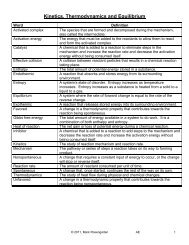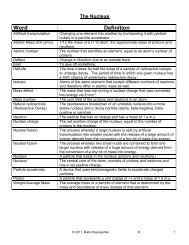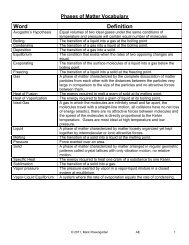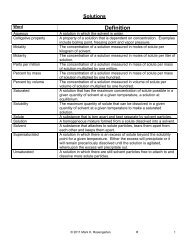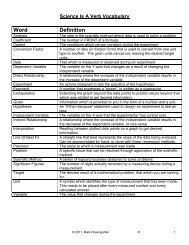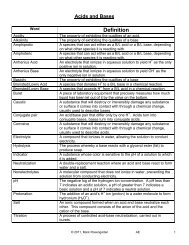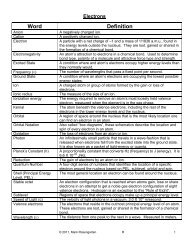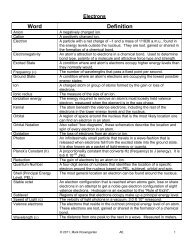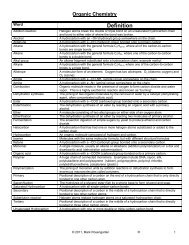Unit 6: Periodic Table and Bonding - Mark Rosengarten
Unit 6: Periodic Table and Bonding - Mark Rosengarten
Unit 6: Periodic Table and Bonding - Mark Rosengarten
Create successful ePaper yourself
Turn your PDF publications into a flip-book with our unique Google optimized e-Paper software.
1) The <strong>Periodic</strong> <strong>Table</strong> (HW: p. 15-21)<br />
Essential Question: How did the structure of the atom influence the design of the <strong>Periodic</strong> <strong>Table</strong>?<br />
Groups<br />
1 2 3 4 5 6 7 8 9 10 11 12 13 14 15 16 17 18<br />
1 H He<br />
2 Li Be B C N O F Ne<br />
3 Na Mg Al Si P S Cl Ar<br />
4 K Ca Sc Ti V Cr Mn Fe Co Ni Cu Zn Ga Ge As Se Br Kr<br />
5 Rb Sr Y Zr Nb Mo Tc Ru Rh Pd Ag Cd In Sn Sb Te I Xe<br />
6 Cs Ba La-<br />
Lu<br />
7 Fr Ra Ac-<br />
Lr<br />
Hf Ta W Re Os Ir Pt Au Hg Tl Pb Bi Po At Rn<br />
Rf Ha Sg Bh Hs Mt Ds Cp Rg<br />
A) Development of the <strong>Periodic</strong> <strong>Table</strong><br />
The <strong>Periodic</strong> <strong>Table</strong> was developed by Dmitri Mendeleev <strong>and</strong> Lothar Meyer in 1869.<br />
The Modern <strong>Periodic</strong> Law<br />
The properties of elements are periodic functions or their atomic numbers.<br />
HUH?<br />
As atomic number increases, certain properties, like number of valence electrons, ionization energy <strong>and</strong> ion charge<br />
repeat periodically. <strong>Periodic</strong>ally? Yes, it means “at certain intervals”. This is why it’s called a PERIODIC table!<br />
Elements are ordered in rows called PERIODS <strong>and</strong> columns called GROUPS.<br />
Direction Importance Examples<br />
PERIODS All elements in the same period have the Na, Mg, Al, Si, P, S, Cl <strong>and</strong> Ar are all in Period 3. They all<br />
(rows) same number of principal energy levels have three PEL’s in their atomic structure.<br />
GROUPS<br />
(columns)<br />
in their atomic structure<br />
All elements in the same group have the<br />
same number of valence electrons,<br />
therefore lose or gain the same number<br />
of electrons, form similar chemical<br />
formulas <strong>and</strong> have similar chemical<br />
properties<br />
Li, Na, K, Rb, Cs <strong>and</strong> Fr are all in Group 1. They all have<br />
one valence electron, they all lose one electron when forming<br />
+1 ions, <strong>and</strong> they are all extremely reactive. They have<br />
similar chemical properties <strong>and</strong> form the following formulas<br />
when bonding to oxygen: Li 2 O, Na 2 O, K 2 O, Rb 2 O, Cs 2 O <strong>and</strong><br />
Fr 2 O.<br />
B) Sizes Of Atoms<br />
Atomic radius - 1/2 the measured distance between two nuclei of the element in the solid phase.<br />
a) Within a period of the table, the radius generally decreases as the atomic number<br />
increases. This is due to an increase in nuclear charge as the atomic number increases,<br />
causing an increase in attraction between the nucleus <strong>and</strong> the valence electrons, pulling them<br />
closer together.<br />
Example: In Period 3, the all of the valence electrons are in the same energy level (3). As<br />
the atomic number increases, the number of protons increases. Na has 11 protons, Mg has<br />
12, Al 13, Si 14, <strong>and</strong> so on. As the number of positive protons increases, the attraction<br />
between the electrons <strong>and</strong> the nucleus increases, making each successive<br />
atom smaller than the previous one.<br />
© 2011, <strong>Mark</strong> <strong>Rosengarten</strong> AE 3



